Multi Carrier Shadow Rates
TransVirtual allows the ability to setup Shadow Rate cards (click here for more information) which are essentially other rate cards that a customer can potentially acquire prices from, rather than their own dedicated rate card.
Freight Managers and Warehouses can make use of this when setting up rates for their customers - Freight Managers/Warehouses being a business that coordinates the movement of freight from start to finish and does not actually perform any deliveries themselves - they use carriers to perform pickups/deliveries.
This article will detail a basic example of how these businesses could make use of the Shadow rate concept within TransVirtual.
Freight Managers and Warehouses can make use of this when setting up rates for their customers - Freight Managers/Warehouses being a business that coordinates the movement of freight from start to finish and does not actually perform any deliveries themselves - they use carriers to perform pickups/deliveries.
This article will detail a basic example of how these businesses could make use of the Shadow rate concept within TransVirtual.
How to
To start with, you will need to ensure that all relevant customers and agent/carriers have been setup under the Card Files section of TransVirtual.
This is important because you need to be able to nominate a customer/agent when creating a rate card.
Please click here for information on how to create customers/agents - this help link is for customers but creating agents is essentially the same thing, just done from the Agent/Supplier List page/tab instead.
For this example, let's say that you have a customer that you offer business to and they are named Broker Customer.
For this customer of yours you are going to use TNT and Toll to action their consignments - these will be the carriers that this customer uses to get their freight either picked up or delivered.
Before you can start creating Shadow Rates, you need to ensure that all agent/carrier or customer rate cards have been setup.
In our example, we need to ensure that agent rates have been setup for TNT and Toll - click here for more information on how to setup a rate card (this link is for customers but the same setup process applies to agent rate cards).
Once all rate cards have been setup, proceed to the Customer Rate Card page in TransVirtual (Finance > Rate Cards > Customer Rate Cards OR Finance > Configuration and Setup > Transport Rates > Customer Transport Rates) and click New Rate:

This is important because you need to be able to nominate a customer/agent when creating a rate card.
Please click here for information on how to create customers/agents - this help link is for customers but creating agents is essentially the same thing, just done from the Agent/Supplier List page/tab instead.
For this example, let's say that you have a customer that you offer business to and they are named Broker Customer.
For this customer of yours you are going to use TNT and Toll to action their consignments - these will be the carriers that this customer uses to get their freight either picked up or delivered.
Before you can start creating Shadow Rates, you need to ensure that all agent/carrier or customer rate cards have been setup.
In our example, we need to ensure that agent rates have been setup for TNT and Toll - click here for more information on how to setup a rate card (this link is for customers but the same setup process applies to agent rate cards).
Once all rate cards have been setup, proceed to the Customer Rate Card page in TransVirtual (Finance > Rate Cards > Customer Rate Cards OR Finance > Configuration and Setup > Transport Rates > Customer Transport Rates) and click New Rate:
You will then see the below window appear:
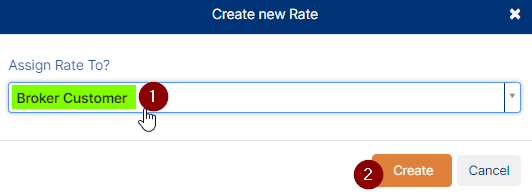
As per the above, select the relevant customer and then click Create.
This then creates the rate card - it will appear in orange in your list of customer rate cards.
Click on it and the settings for it will appear on the right-hand side:
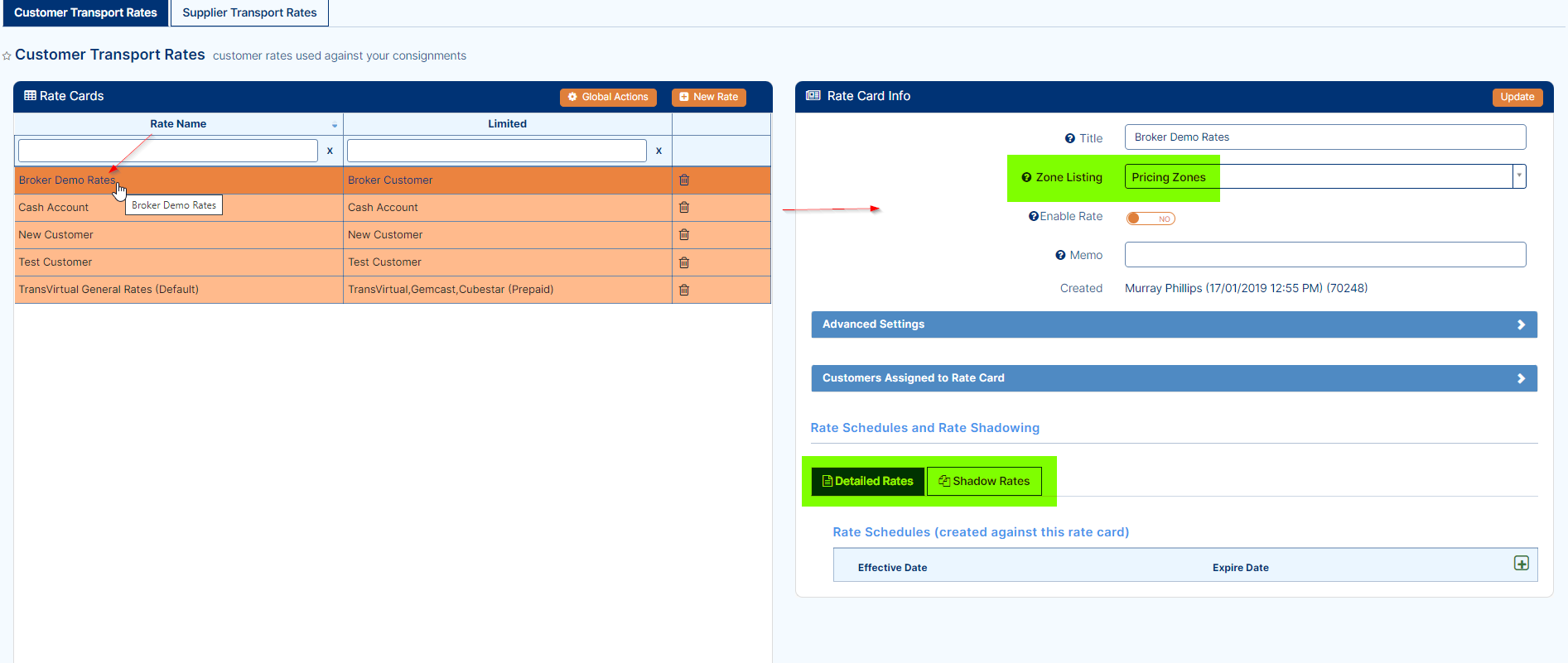
Normally with customer rate cards you would setup a zone list and then create a detailed rate for the customer - the reason this is done is because typically most freight companies would deliver any connotes within their own account (detailed rates are simply the rates you offer your customer to deliver the freight - you deliver in this scenario).
As per the above, select the relevant customer and then click Create.
This then creates the rate card - it will appear in orange in your list of customer rate cards.
Click on it and the settings for it will appear on the right-hand side:
Normally with customer rate cards you would setup a zone list and then create a detailed rate for the customer - the reason this is done is because typically most freight companies would deliver any connotes within their own account (detailed rates are simply the rates you offer your customer to deliver the freight - you deliver in this scenario).
However, for this example, we actually need to click on the Shadow Rates tab at the bottom of this page, against this rate card:
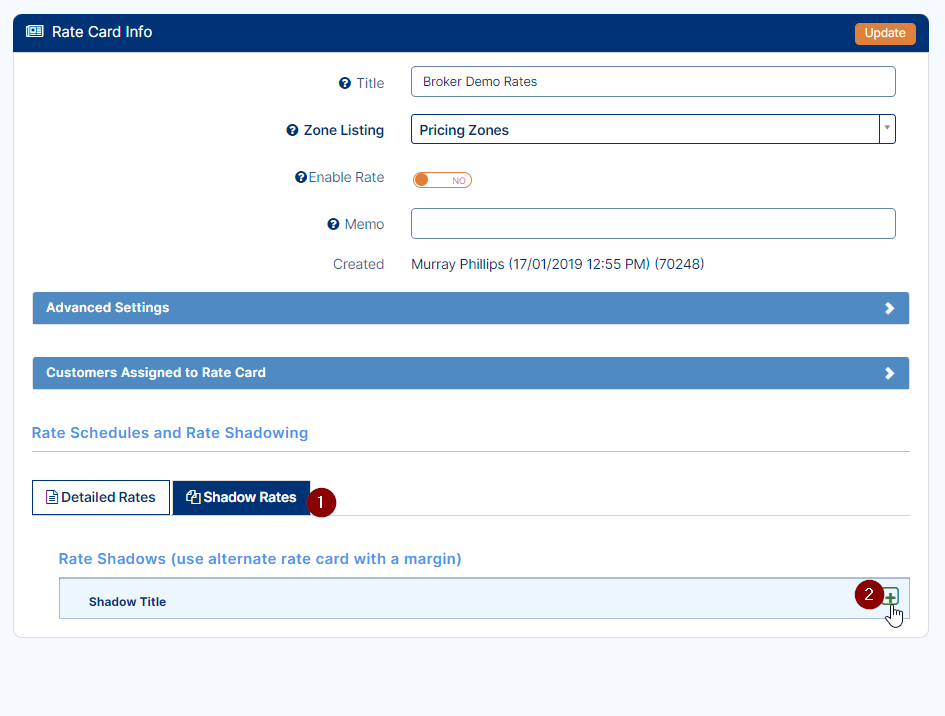
This section here is where you nominate alternate rate cards for this customer; so, for this example, TNT and Toll are going to be the carriers used for this customer, so their rate cards need to be added to this customer rate card as shadow rate options so that the customer can potentially use their prices and consign through them.
Click the green plus icon and add the relevant rate cards:

If needed, you can click the drop-down arrows next to each Shadow rate option and add in a margin/markup:
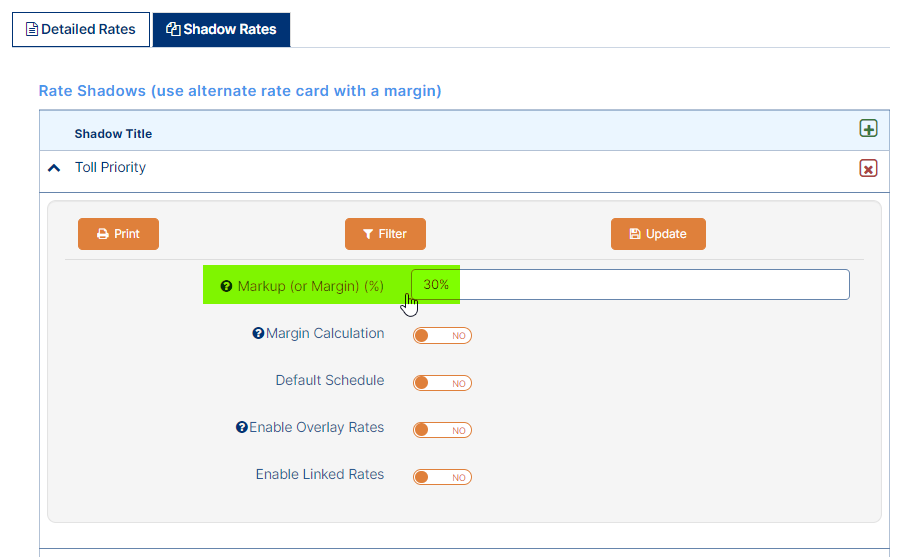
Due to the nature of this setup, whatever number or % you enter here is on top of the existing rates for that Shadow rate card.
This setting would allow you to add in your margin or 'take a cut' to ensure you make money and can continue operating etc (the rates the customer is charged are that % higher than what is listed originally in the rate card, the difference is what you take).
Customer Users attached to this Broker Customer can now select a price from one of these two options and the services contained within.
Click the green plus icon and add the relevant rate cards:
If needed, you can click the drop-down arrows next to each Shadow rate option and add in a margin/markup:
Due to the nature of this setup, whatever number or % you enter here is on top of the existing rates for that Shadow rate card.
This setting would allow you to add in your margin or 'take a cut' to ensure you make money and can continue operating etc (the rates the customer is charged are that % higher than what is listed originally in the rate card, the difference is what you take).
Customer Users attached to this Broker Customer can now select a price from one of these two options and the services contained within.

Make sure to enable the rate card!
What does this look like from a customer perspective?
Once the above has been setup, customers (those belonging to Broker Customer) can now login to your account, head to the consignment creation page, fill out their consignment details, then choose from and select from a range of different prices available to them:
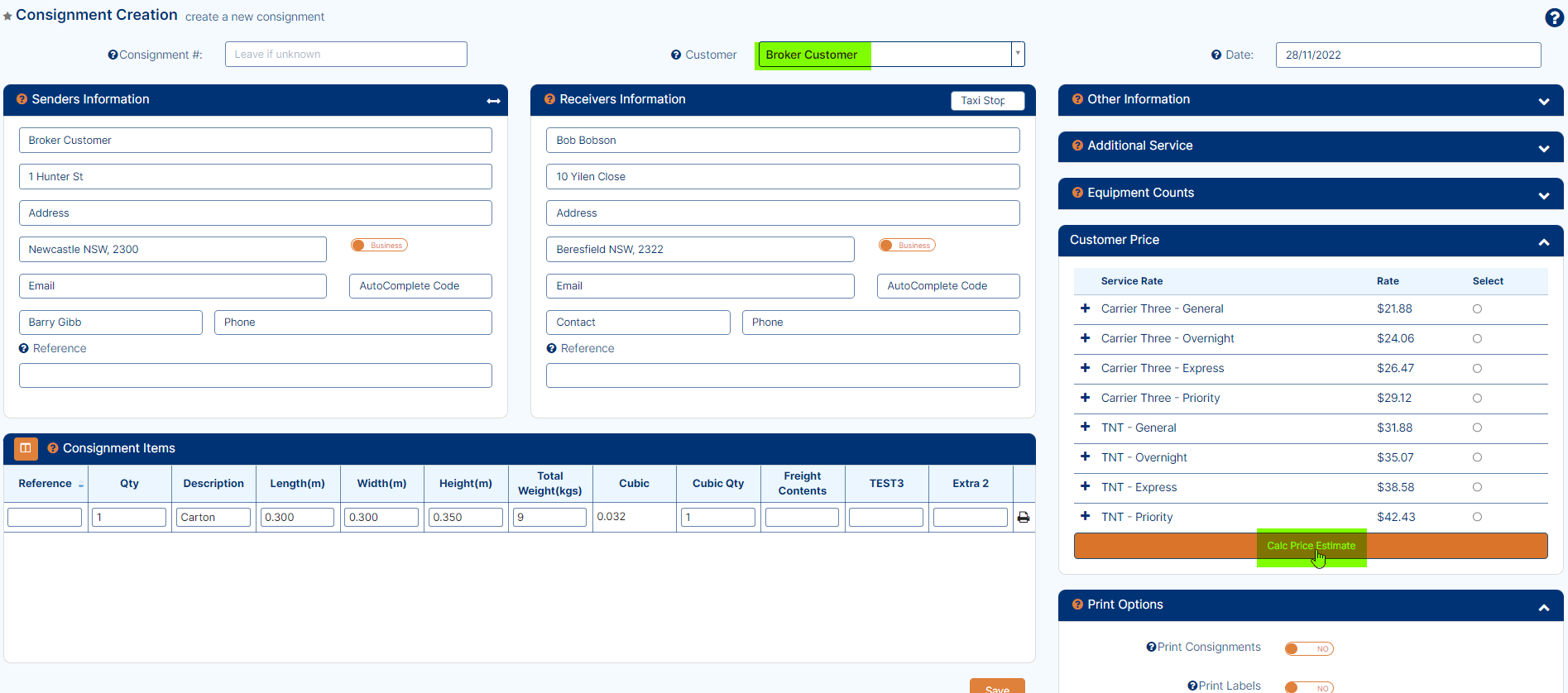
As you can see in the above, if a customer login were to enter these details and then click the Calc Price Estimate button, they are returned with many different pricing options - these are all of the applicable service types and prices from each available rate card they are attached to which includes Shadow rate cards.

The options that appear here are actually the names of the different service levels from within each applicable rate card for this customer - this example only has 2 being the TNT and Toll shadow rate cards.
Clicking the plus icon next to each service type/price, provides a bit more information on how that price was formed:
If the customer wishes/is required to, they can select an available price by clicking like so:
Selecting a price and then saving the consignment assigns the consignment to the agent/carrier attached to that price (if applicable) and this assignment typically forms the trigger for EDI rules to send data across to said agent's system - if they do not use TransVirtual etc (typically these types of setups involve a lot of integrations where data is sent and received to/from other systems).

Note: It is possible to 'force' customers to have to select a price. To do this, open up their customer card, go to consignment related rules and then enable the below setting:
This can also be done at a global level within the consignment related rules tab of the Global Setup page.
Extra Information
In the above you may have noticed the prices returned were agent name - service level type, like so:
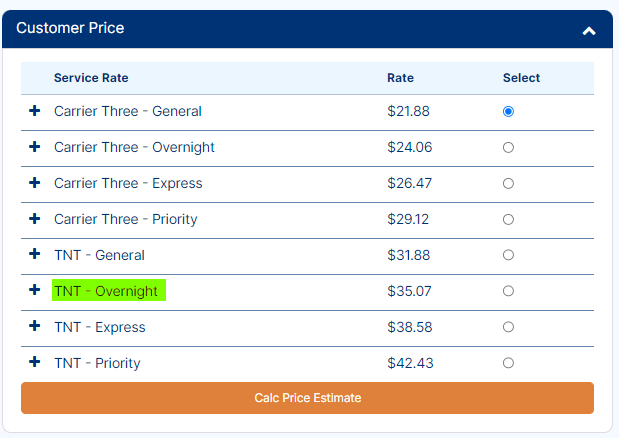
Whether or not you choose to setup your shadow/agent rates in this manner is entirely up to you and your team.
These prices are derived from the relevant rate card:
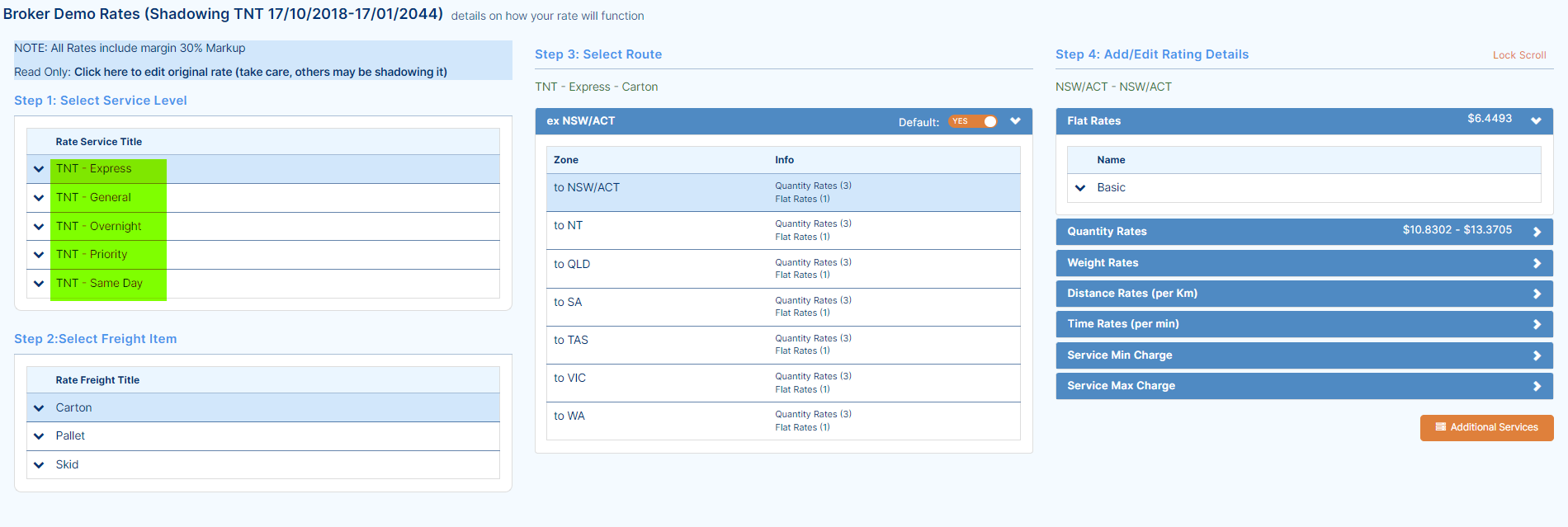
Whether or not you choose to setup your shadow/agent rates in this manner is entirely up to you and your team.
These prices are derived from the relevant rate card:
The way in which the Service Level names have been setup in the rate cards is how they will be displayed if they are returned and appear as a Price result on consignment creation as per the above.
Typically, when it comes to setting up agent rate cards and their Service Levels, the advised naming convention is Agent Name - Service Level.
The reason for this is that then when a price calculation is done you and the customer can see exactly which carrier prices are being returned.
This setup also helps when setting up the Shadow rates initially as you can test and ensure prices are being returned.
Typically, when it comes to setting up agent rate cards and their Service Levels, the advised naming convention is Agent Name - Service Level.
The reason for this is that then when a price calculation is done you and the customer can see exactly which carrier prices are being returned.
This setup also helps when setting up the Shadow rates initially as you can test and ensure prices are being returned.
However, this is not a requirement.
If you do not wish for you customers to know what agent/carriers you send freight with, you can simply name the service levels "General", "Express", and so on.
If you do not wish for you customers to know what agent/carriers you send freight with, you can simply name the service levels "General", "Express", and so on.
Other Considerations
So far, this article has run through the pricing side of things when setting up a TransVirtual account for a Freight Manager or Warehouse.
Other things you will or may need to consider when setting up your account would be Transit Times and Auto-Assignment.
Other things you will or may need to consider when setting up your account would be Transit Times and Auto-Assignment.
Related Articles
TransVirtual Rates
TransVirtual Rates Your current rates can be found on the Rates and Modules Page (Settings > TransVirtual Account > Rates and Modules). Rates are applied as follows: Base Rate - Required Charged per consignment created, irrespective of scans or ...Tax Rates
In TransVirtual there is the ability to create custom tax rates, if required. Typically, the tax rate in Australia is defined as GST (Goods and Services Tax) and is usually a 10% tax applied to most goods or services. This article will detail how to ...Rates and Modules
This article will describe the features within Rates and Modules Field Descriptions The rates and modules setup enables you to turn on or off many of the features whilst displaying their respective costs., The current Modules that exist are: Pricing ...Delivery
Delivery This article will describe how to perform a basic delivery within the TransVirtual mobile application. From the main page, after loading your consignment(s)/item(s), tap on the delivery button This will present all the consignments loaded ...Enterprise TMS Core Feature List
TransVirtual Enterprise Edition provides the full range of TMS features and flexibility. It combines rapid out-of-the-box functionality with the a vast range of enterprise level customizations and configuration. Account Management Customers and ...